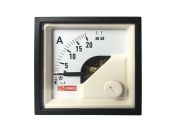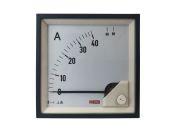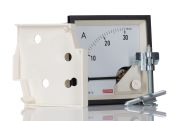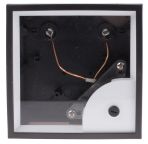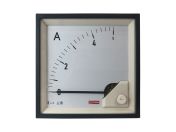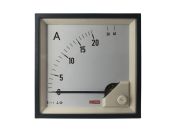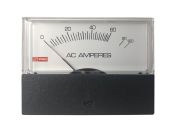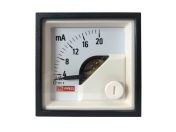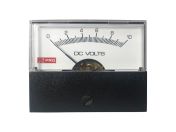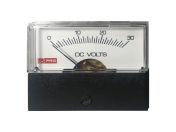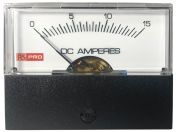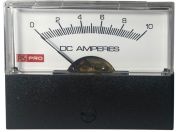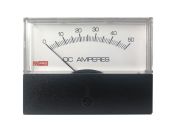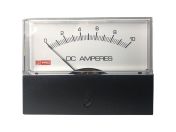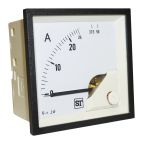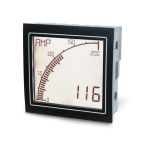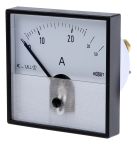Ammeters
Ammeters, or ampere meters, are used to measure electric current in a circuit. Electricians, technicians, engineers, and students employ ammeters to measure currents in everything from industrial machinery to experimental setups. RS Philippines offers a wide range of high-quality ammeters, including digital ampere meters and analog ammeters, to meet diverse electrical measurement needs.
What Is a Digital Ammeter?
A digital ammeter is an electronic device that measures and displays electric current in a digital format, typically using an LCD or LED screen. Known for their high precision, good digital ampere meters may have minimal error margins within the 0.5% ballpark.
Aside from the ammeter's digital display, some models may include other useful features such as data logging, peak hold, and programmable alarms. The latter function is useful for alerting users when the current either exceeds or falls below a certain threshold.
Digital ammeters are ideal for environments requiring precise current measurements, such as laboratories, industrial settings, and fieldwork.
What Is an Analog Ammeter?
Analog ammeters, also known as ampere meters or panel ammeters, use a needle on a calibrated dial to indicate current magnitude, relying on electromagnetic moving coil or moving iron mechanisms. When current flows through the coil, it creates a magnetic field deflecting the needle proportionally to the current level. Analog ammeters are valued for durability and sensitivity to rapid current changes, making them suitable for use in educational settings and continuous monitoring applications where clear visual indicators are critical.
Types of Ampere Meters
Moving Coil Ammeters
Although they are not strictly DC ammeters, they are chiefly designed for measuring DC current. They use a coil suspended in a magnetic field with a hairspring for restoring force. They provide excellent accuracy and are commonly used in instrumentation and low-current applications.
Moving Magnet Ammeters
Similar in function to moving coil types, but with a fixed coil and moving magnet. Since the coil is constructed from thicker wire and no hairspring is needed, these meters can withstand higher currents and are generally more robust.
Moving Iron Ammeters
Capable of measuring both AC and DC, moving iron ammeters use soft iron vanes sensitive to magnetic fields. They are widely used in industrial and commercial panels due to their durability and versatility.
Digital Panel Ammeters
These feature an LED or LCD display excellent for low-light operations. They often support programmable ranges, alarms, or current transformer (CT) inputs. They provide precise, easy-to-read measurements and are ideal for modern automation, monitoring, and control systems.
Clamp & CT-Based Ammeters
Instead of connecting in series with the circuit, these ammeters use a current transformer or clamp mechanism to measure current indirectly. This design enables safe measurement of high currents and monitoring of live circuits without disconnection.
Milli- & Micro-Ammeters
Designed for very small currents in the milliampere or microampere range, these specialised ammeters are common in electronics laboratories and sensor testing, providing fine measurement resolution. They can also detect subtle issues such as insulation faults.
How to Choose the Right Ammeter
Aside from ampere meter price, here are some other factors to consider when shopping for ammeters:
- Measurement Type: Determine whether you need to measure AC, DC, or both.
- Current Range: Choose an ammeter that can accurately measure the expected current range. Ensure that it can safely handle the circuit's maximum current.
- Accuracy Requirements: Consider the level of precision needed for your application. While digital ammeters may be more accurate, analog ammeters are better for measuring rapid changes in current.
- Environment: Assess the operating conditions, such as temperature, humidity, and potential exposure to corrosive substances.
- Display Type: Digital displays may be useful for low-light environments, whereas analog displays are suitable for introductory classroom readings. Also note that ammeter prices for digital models in the Philippines and all over the world are usually costlier.
Applications of Ammeters
- Industrial Settings: Ammeters are used to monitor current flow in heavy machinery and control systems, ensuring efficient operation and preventing equipment overload.
- Laboratories: Scientists and researchers use ampere meters to take precise current measurements in experiments involving circuits, electronics, and materials science.
- Fieldwork: Technicians use portable ammeters for on-site diagnostics, troubleshooting electrical issues, and performing safety checks on equipment.
- Educational Institutions: Panel ammeters are used in classrooms to teach students about electricity, Ohm's Law, and how to measure current in simple and complex circuits.
Why Buy Ammeters from RS Philippines
RS Philippines is a trusted supplier and distributor of high-quality online ampere meters, analog ammeters and DC ampere meters at reasonable prices. We carry a wide range of products from industry leaders such as Socomec, Sifam Tinsley and HOBUT suitable for various applications. We also stock other process control peripherals such as temperature controllers and current transformers. For more information about our ordering process, delivery services, and delivery fees, please refer to our delivery page.
